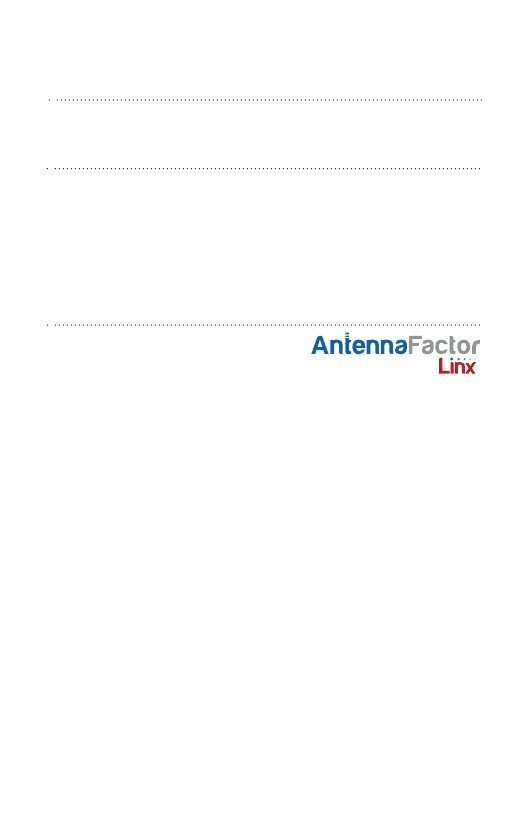- 您现在的位置:买卖IC网 > Sheet目录505 > RXM-418-LC-S (Linx Technologies Inc)RECEIVER RF 418MHZ SMT

General Antenna Rules
The following general rules should help in maximizing antenna
performance.
1. Proximity to objects such as a user’s hand, body, or metal objects will
cause an antenna to de-tune. For this reason, the antenna shaft and tip
should be positioned as far away from such objects as possible.
2. Optimum performance will be obtained from a quarter or half-wave
straight whip mounted at a right angle to the ground plane. In many
cases, this isn’t desirable for practical or ergonomic reasons, thus,
an alternative antenna style such as a helical, loop, or patch may be
utilized and the corresponding sacrifice in performance accepted.
OPTIMUM
USABLE
NOT RECOMMENDED
3. If an internal antenna is to be used, keep it away from other metal
tracks, and ground planes. In many cases, BE the space around the
(MAY NEEDED)
Figure 25: Ground Plane Orientation
CASE
like GROUND PLANE
components, particularly large items transformers, batteries, PCB
NUT
antenna is as important as the antenna itself. Objects in close proximity
to the antenna can cause direct de-tuning, while those farther away will
alter the antenna’s symmetry.
4. In many antenna designs, particularly
quarter-wave whips, the ground plane acts
VERTICAL λ /4 GROUNDED
ANTENNA (MARCONI)
as a counterpoise, forming, in essence,
a half-wave dipole. For this reason,
adequate ground plane area is essential.
The ground plane can be a metal case or
ground-fill areas on a circuit board. Ideally,
it should have a surface area greater than
the overall length of the quarter-wave
radiating element. However, this is often
not practical due to size and configuration
E
I
GROUND
PLANE
VIRTUAL λ /4
DIPOLE
DIPOLE
ELEMENT
λ /4
λ /4
constraints. In these instances, a designer
must make the best use of the area available
– 24 –
Figure 26: Dipole Antenna
发布紧急采购,3分钟左右您将得到回复。
相关PDF资料
RXM-418-LR_
RECEIVER 418MHZ LR SERIES
RXM-869-ES_
RECEIVER RF 869MHZ 16PIN SMD
RXM-GPS-SG-T
GPS MODULE SMD SIRF
RXM-GPS-SR-T
GPS MODULE SMD SIRF W/ANT
RZE002P02TL
MOSFET P-CH 20V 200MA EMT3
RZF020P01TL
MOSFET P-CH 12V 2A TUMT3
RZF030P01TL
MOSFET P-CH 12V 3A TUMT3
RZM002P02T2L
MOSFET P-CH 20V 0.2A UMT6
相关代理商/技术参数
RXM-418-LR
功能描述:射频模块 RF Receiver 418MHz
RoHS:否 制造商:Linx Technologies 产品:Transceiver Modules 频带:902 MHz to 928 MHz 输出功率:- 15.5 dBm to + 12.5 dBm 接口类型:UART 工作电源电压:- 0.3 VDC to + 5.5 VDC 传输供电电流:38.1 mA 接收供电电流:22.7 mA 天线连接器类型:U.FL 最大工作温度:+ 85 C 尺寸:1.15 mm x 0.63 mm x 0.131 mm
RXM-418-LR_
功能描述:RECEIVER 418MHZ LR SERIES RoHS:是 类别:RF/IF 和 RFID >> RF 接收器 系列:LR 产品培训模块:Lead (SnPb) Finish for COTS 产品变化通告:Product Discontinuation 09/Jan/2012 标准包装:50 系列:* 频率:850MHz ~ 2.175GHz 灵敏度:- 数据传输率 - 最大:- 调制或协议:- 应用:* 电流 - 接收:* 数据接口:PCB,表面贴装 存储容量:- 天线连接器:PCB,表面贴装 特点:- 电源电压:4.75 V ~ 5.25 V 工作温度:0°C ~ 85°C 封装/外壳:40-WFQFN 裸露焊盘 供应商设备封装:40-TQFN-EP(6x6) 包装:托盘
RXM-418-RM
功能描述:RECEIVER RF 418MHZ RoHS:否 类别:RF/IF 和 RFID >> RF 接收器 系列:RM 产品培训模块:Lead (SnPb) Finish for COTS 产品变化通告:Product Discontinuation 09/Jan/2012 标准包装:50 系列:* 频率:850MHz ~ 2.175GHz 灵敏度:- 数据传输率 - 最大:- 调制或协议:- 应用:* 电流 - 接收:* 数据接口:PCB,表面贴装 存储容量:- 天线连接器:PCB,表面贴装 特点:- 电源电压:4.75 V ~ 5.25 V 工作温度:0°C ~ 85°C 封装/外壳:40-WFQFN 裸露焊盘 供应商设备封装:40-TQFN-EP(6x6) 包装:托盘
RXM430-408
制造商:未知厂家 制造商全称:未知厂家 功能描述:Analog IC
RXM-433-LC
制造商:未知厂家 制造商全称:未知厂家 功能描述:LC SERIES TRANSMITTER MODULE
RXM-433-LC-P
制造商:未知厂家 制造商全称:未知厂家 功能描述:LC SERIES RECEIVER MODULE DATA
RXM-433-LC-S
功能描述:RECEIVER RF 433MHZ SMT RoHS:否 类别:RF/IF 和 RFID >> RF 接收器 系列:LC 产品培训模块:Lead (SnPb) Finish for COTS 产品变化通告:Product Discontinuation 09/Jan/2012 标准包装:50 系列:* 频率:850MHz ~ 2.175GHz 灵敏度:- 数据传输率 - 最大:- 调制或协议:- 应用:* 电流 - 接收:* 数据接口:PCB,表面贴装 存储容量:- 天线连接器:PCB,表面贴装 特点:- 电源电压:4.75 V ~ 5.25 V 工作温度:0°C ~ 85°C 封装/外壳:40-WFQFN 裸露焊盘 供应商设备封装:40-TQFN-EP(6x6) 包装:托盘
RXM-433-LR
功能描述:射频模块 RF Receiver 433MHz
RoHS:否 制造商:Linx Technologies 产品:Transceiver Modules 频带:902 MHz to 928 MHz 输出功率:- 15.5 dBm to + 12.5 dBm 接口类型:UART 工作电源电压:- 0.3 VDC to + 5.5 VDC 传输供电电流:38.1 mA 接收供电电流:22.7 mA 天线连接器类型:U.FL 最大工作温度:+ 85 C 尺寸:1.15 mm x 0.63 mm x 0.131 mm
